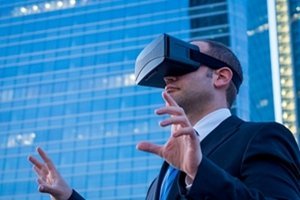For many, virtual reality still feels like an out-of-reach experience. Only 8% of the US population has tried immersive VR. Throw in concerns about how your body would react to prolonged use, the considerable expense involved in both creating and viewing VR content, and the lack of tangible metrics, and it’s easy to see why many marketers are wary of VR marketing.
But what is virtual reality exactly? A report by Forrester Research found that 42% of US online adults have never heard about VR headsets.
Here are some examples of available VR and augmented reality (AR) technology:
- Headset VR. This experience typically involves a headset, sensors, and a VR-enabled PC. Though it is the most immersive, it is also the most expensive, making widespread adoption challenging. Some examples are the HTC Vive and Oculus Rift.
- Lo-fi VR. An example of this type of experience is Google Cardboard and other headsets that use a smartphone as part of the system. One application commonly used with this tech is 360-degree video, which allows users to look around from various perspectives within a video. There is a good deal of debate around whether 360 videos should be considered VR at all, but for most consumers it is their first VR-like experience.
- AR. Though it’s not technically virtual reality, you can think of it as a sibling of sorts. Whereas virtual reality offers a digital recreation of a real-life setting, AR delivers virtual elements as an overlay to the real world. As in VR, there are varying levels of expense and immersion. The Microsoft HoloLens is perhaps one of the most well-known AR products, but it is still currently only available to the developer community.
The popular Pokémon Go game showed that AR doesn’t have to be tied to a headset experience; it can in fact be tied to your mobile device. Another smartphone app, Augment, is banking on AR’s driving sales by allowing users to see the item they are considering purchasing in the actual space in their home where it might live.
Other areas being explored include education, training, and product development. Imagine a car designer being able to manipulate and refine 3D parts in an immersive way. This approach could save millions of dollars in design and development across a myriad of business models.
Today, brands such as Converse, Lego, Nike, and Ikea are using smartphone apps to deliver AR experiences to their customers. Social networks, including Snapchat, have also harnessed AR to create shareable experiences and have begun to partner with brands to leverage their (the networks’) audience and tech.
Why should you care about VR/AR?
In a recent survey, Greenlight VR found that 71% of consumers say brands that have created VR experiences seem “forward-thinking and modern.” The same survey also found that 53% of respondents would be more likely to purchase from a brand that uses VR versus one that doesn’t.
Although the entry point into VR/AR may be costly now, we will continue to see the technology become more accessible both to creators and users.
And history shows that businesses that have been resistant to new tech and ideas have often either fallen behind the times or lost the ability to compete in their space. By the time Microsoft took mobile seriously, for example, it had already missed its opportunity to gain serious market share, allowing Google to capture 88% of global smartphone OS share.
I recently had a conversation with an account executive about VR opportunities at tradeshows. His first response was, “I’ve never seen a VR experience at any tradeshow I’ve ever been to.” That statement was meant to demonstrate that it was not a common thing, and thus not realistic or feasible.
I shot back, “Exactly!” Because the time to innovate is not after everyone else has already done something.
Perhaps agencies tend to be too bullish on VR, considering the current cost of production. But the reality is that at some point, soon, VR and AR experiences will be created with ease, and we won’t be producing this type of content to wow consumers or position your brand as forward-thinking: It will be a go-to medium of expression.
Is VR right for you?
Here are a few questions posed in a recent Think With Google, What Virtual Reality Will Mean for Advertising, that can help you determine whether your organization is the right fit for VR:
- Will VR give viewers an experience that they otherwise couldn’t have? The subject matter should truly take advantage of the medium—transport people to a place, immerse them in a world, and compel them to explore.
- Could you give shoppers a better feel for your product? According to a study from Ericsson ConsumerLab, shopping was the top reason worldwide smartphone users were interested in VR, with “seeing items in real size and form when shopping online” cited by 64% of respondents. This doesn’t just apply to retail brands. Cadillac is already using VR to create virtual dealerships.
- Will your recording environment be rich with things to see? If you’re shooting in a simple white room with nothing on the walls, probably not. If you’re at a sports event or a music festival, there’s likely plenty to see.
If you’re working with enterprise brands, consumer products, or companies in the travel, tourism, and adventure industries, VR/AR may already be one of the best ways to immerse a younger audience in your brand. But to answer the question of whether most marketers should adopt VR, the answer is no, probably not yet.
Still, even if you don’t adopt these technologies today, don’t tune them out entirely. Though VR and AR haven’t reached a saturation point, it’s likely they will eventually become the norm; and, when they do, the most successful brands will be those that are prepared to use these technologies to solve problems, tell stories, and create brand affinity.

